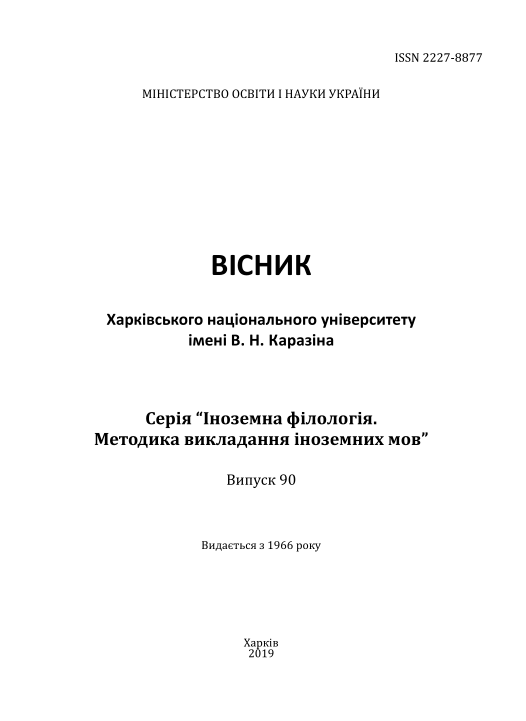Sensual and conceptual component of the conceptual binary opposition HUMAN BEING – TECHNOLOGY in the works by Ray Bradbury
Abstract
The article is focused on the study of the sensual and conceptual component of the conceptual binary opposition human being – technology in Ray Bradbury’s works. The relevance of the research is based on the constant interest of the scientists in the study of binary opposition. The duality of world perception results in writers’ (including Ray Bradbury ) using binary oppositions as a means of conveying their own attitude to the spiritual values on mankind and the very sense of the world. The research identifies the theoretical prerequisites for the duality of human perception; reveals the methodology of frame analysis of concepts as members of binary oppositions; investigates the characteristics of concepts human being and technology as oppositions in Ray Bradbury’s works. The study shows that binary oppositions in the fictional text are preconditioned by the very nature of fiction. Binary oppositions in the fictional text have sensual and conceptual content, thus, the analysis of binary oppositions in the works of a writer gives the opportunity to identify the peculiarities of the writer’s worldview and to understand it in a more profound way. Binary oppositions are realized in the form of opposition of concepts as basic units of the cognitive code of humans with a relatively ordered internal structure. The study of concepts is carried out through the construction of frames as a means of generalized visual concept scheme. It is based and modeled on the relevant sources, collected in a single system of research and illustrative resources, and their graphical representation. This gives the possibility to identify the components of each concept and to analyze the parameters which the author considers to oppose the concepts. It is revealed that the binary opposition human being – technology in Ray Bradbury’s works is represented as an opposition of the key slots of these concept. Thus, it can be considered as a direct opposition of such slots as: animate – inanimate on the basis of functioning; feeling – insensibility on the basis of emotional capability of the world perception; interest – staticity on the basis of the cognitive abilities, and creativity – predation on the basis of the principle aim of a human being and technology.
Downloads
References
Barantsev, R. G. (2005). Stanovlenie trinitarnogo myshlenija [The formation of trinitarian thinking]. Moscow – Izhevsk: NIC “Reguljarnaja i haoticheskaja dinamika”.
Verstin, I. S. (2013). Pervobytnoe myshlenie i koncepcija binarnyh oppozicij A. M. Zolotareva [Primitive thinking and the concept of binary oppositions by A. M. Zolotarev], Vestnik Rossijskogo jekonomicheskogo universiteta imeni G. V. Plehanova – Vestnik of the Plekhanov Russian University of Economics, 6, 55–62.
Dovbnia, N. P. (2011). Evolyuciya binarnoyi struktury prostoru u franczuzkii, anglijskii ta ukrayinskii movax : Avtoref. diss. kand. filol. nauk [Evolution of the binary structure of space in French, English and Ukrainian : Cand. philol. sci. diss. synopsis]. Kyiv (in Ukrainian).
Zalevskaya, A. A. (2005). Psiholingvisticheskie issledovanija. Slovo. Tekst: Izbrannye trudy [Psycholinguistic research. Word. Text: Selected Papers]. Moscow: Gnozis.
Lysyi, V. (2009). Yednist i borotba protylezhnostei yak dialektychna superechnist [Unity and the struggle of opposites as a dialectical contradiction], Visnyk Lvivskogo universytetu – Visnyk of Lviv University, 12, 15–25.
Martynyuk, L. P. (2010). Opyt modusnogo modelirovanija koncepta (na primere koncepta CELEBRITY/ ZNAMENITOST, aktualizirovannogo v anglojazychnom gazetnom diskurse) [The experience of modus concept modeling (based on the CELEBRITY / CELEBRITY concept, actualized in the English newspaper discourse)], Kognicija. Kommunikacija. Diskurs – Cognition, Communication, Discourse, 1, 93–100.
Popova, Z. D., Starnin, I. A. (2007). Kognitivnaja lingvistika [Cognitive Linguistics]. Moscow: ACT: Vostok.
Stepanov, V. V., Shvachko S. O. (2016). Freimove modeliuvannia konceptiv na materiali paralelnogo korpusu paremii [Frame modeling of concepts based on the material of the parallel corpuse of paremiae], Filologichni traktaty – Philological Tractates, 8 (1), 69–78.
Sukhomlinova, Yu. A. (2005). Binarnye oppozicii v tvorchestve Andreja Platonova : Avtoref. diss. kand. filol. nauk [Binary oppositions in the works by Andrei Platonov : Cand. philol. sci. diss. synopsis]. Samara (in Ukrainian).
Taranets, V. G. (2000). Pokhodzhennia ponyattya chysla i yogo movnoi realizacii (do vytokiv indoyevropeiskoi pramovy) [The origin of the concept of number and its linguistic realization (to the origins of Indo-European language)]. Odesa: AstroPrint.
Trubetskoi, N. S. (2000). Osnovy fonologii [Basics of Phonology]. Moscow: Aspect Press.
Bradbury, R. Fahrenheit 451 [Electronic resource]. URL: https://www.secret-satire-society.org/wp-content/uploads/2014/01/Ray-Bradbury-Fahrenheit-451.pdf.
LeDoux, J. (1994). Emotion, memory and the brain, Scientific American, 270 (6), 50–57.
LeDoux, J. (1994). The emotional brain: The mysterious underpinnings of emotional life. New York: Touchstone Books.
Minsky, М. (1975). A Framework for Representing Knowledge, The Psychology of Computer Vision. New York: McGraw-Hill, 211–277.
Wood, J. D., Petriglieri, G. (2005). Transcending Polarization: Beyond Binary Thinking, Transactional Analysis Journal, 35 (1), 31–39.




